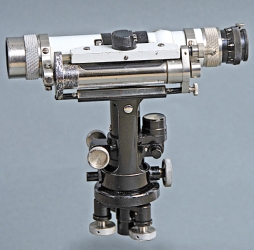Scientific Instrument Society 25th Anniversary Exhibition
Navigation:
<< First | < Previous | Next > | Last >>
46 Zeiss Level I
The Swiss surveyor Heindrich Wild (1877-1951) was the dominant influence on surveying instrument design for more than fifty years. After working for the official Swiss Survey Office (Eidgenössischen Topographischen Bureaus), he moved his wife and 5 children to Jena, Germany to join the firm of Carl Zeiss as head of their new Geo Department. His first project was a new level.
The radical departure of the design of the Zeiss Level I by Heindrich Wild in 1908 persuaded Zeiss to commence the manufacturing of geodetic surveying instruments. The Level I when shown at the surveyor's conference in Baden in Freiberg in 1910 was considered an “epoch-making sensation.” By 1911, it was joined by the Level II and the Level III which introduced further ground-breaking advantages.
The Zeiss Level 1 incorporated the following new improvements:
- The co-incidence split bubble - the bringing together of the semi-meniscus images of the bubble vial by a series of prisms thereby increasing the accuracy 3 to 5 fold.
- Internal focussing of the main telescope - which improved telescope balance, trueness of the line of sight and made the sealed telescope much shorter.
- The bi-axial revolving telescope and bubble about the line of sight removed the effects of possible maladjustment of the instrument.
- The replacement of the spider webs of the main telescope with cross hairs etched on a glass reticule permitted the telescope to be sealed.
- A new cylindrical vertical axis.
This instrument marked the beginning of a design process by Heindrich Wild which had a profound effect on the direction of instrument manufacture worldwide for the following three-quarters of a century. The size, weight, stability, accuracy, compactness, operational convenience, manufacturing methods, materials and finish completely changed with his new designs and became the standard for an entire industry.
Collection: John Bradley, Ireland
After World War I Wild returned from Germany to Switzerland to found his own company in Heerbrugg which produced the extremely successful T2 Universal Theodolite in the 1920s. Moving on again, he became consultant design engineer to the firm of Kern in Aarau in the 1930s and produced a distinctive series of theodolites which remained in production for 50 years.
S.J.
Objects lent by John Bradley, Dublin, Ireland:
39. DKM-3A Theodolite, by Kern, Aarau, c. 1950s, with Favag Chronograph

